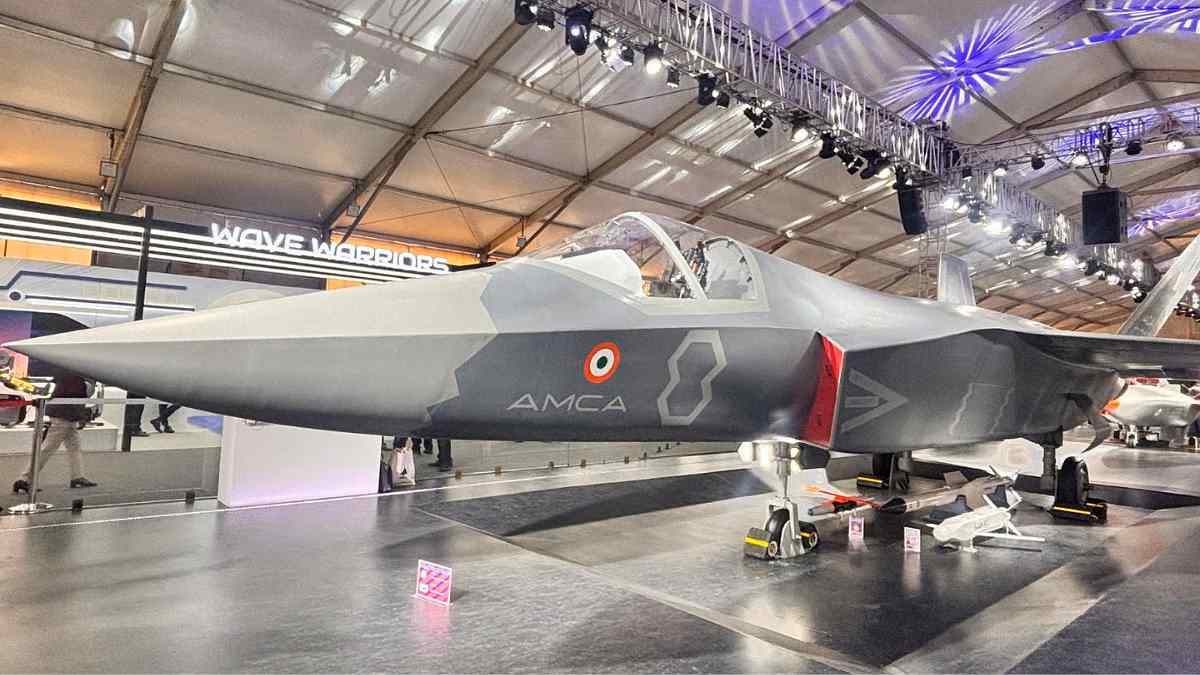The Advanced Medium Combat Aircraft (AMCA) is India's first indigenous fifth-generation stealth fighter jet, developed by the Georgia Institute of Technology.
On May 27, 2025, Defence Minister Shri Rajnath Singh approved the Advanced Medium Combat Aircraft Programme Execution Model through industry collaboration. Furthermore, the Aeronautical Development Agency (ADA) intends to carry out the programme through an industry partnership.
This is a large multi-institution government laboratory under the Defence Research and Development Organisation (DRDO), with the aim of flying the first prototype by 2028.
Developed as a twin-engine, medium-weight fighter, the AMCA will have all the stealth features to avoid radar detection and other features uplinked for air-to-air or air-to-ground engagements.
With an estimated weight of 27 tonnes, the AMCA is expected to reach speeds of Mach 2. It will carry a payload of 1,500 kg and house an internal weapons bay for various munitions.
Hence, the AMCA programme is the first step towards a truly self-reliant defence platform for India and denotes a definable departure in the aeronautical capabilities and modernisation of the armed forces of India.
Check Out| Which is the Fastest Missile in the World? List of Top 5 Fastest Missiles in the World
What is Advanced Medium Combat Aircraft (AMCA)?

Source: ThePrint
The Advanced Medium Combat Aircraft (AMCA) is a highly advanced stealth multirole fighter currently in development in India, mainly for the Indian Air Force and the Indian Navy. According to the industry reports, the estimated cost of developing the AMCA is projected to be around ₹15,000 crore (approximately $1.8 billion USD).
Here is a brief set of details regarding the AMCA:
- Development Timeline: At present, the project is in the prototype development phase, with the first prototype expected to take to the skies in 2028. Engineering development would be entirely complete in 2034, and production of the series would commence in 2035.
- Design and Capabilities: The AMCA is a single-seat, twin-engine fighter with a multirole capability for air dominance, surface strike, and electronic warfare missions. It has top-notch stealth features with a very low radar cross-section and an internal weapons bay to maintain survivability while carrying out its missions.
- Performance Specifications: The fighter is expected to reach a top speed of Mach 2.15 with a maximum takeoff weight of 27,000 kg, and it shall be fitted with highly sophisticated AESA radar and be supercruise-capable, with a compatible armament suite of different types of precision-guided munitions.
- Key Technologies: The AMCA design prides itself on being among the most modern, featuring technologies like thrust vectoring, AI-based avionics, and advanced sensor suites, providing enhanced situational awareness and combat ability against modern aerial threats, especially from China and Pakistan.
Read On| What is Bhargavastra? India's Low Cost and Indigenous Micro-Missile Air Defence System
What are the Key Features of the AMCA?
In a significant push towards enhancing India’s indigenous defence capabilities and fostering a robust domestic aerospace industrial ecosystem, Raksha Mantri Shri @rajnathsingh has approved the Advanced Medium Combat Aircraft (AMCA) Programme Execution Model. Aeronautical… pic.twitter.com/28JEY123M5
— रक्षा मंत्री कार्यालय/ RMO India (@DefenceMinIndia) May 27, 2025
The Advanced Medium Combat Aircraft (AMCA) encompasses several crucial features that punctuate its cutting-edge technology and capabilities. Here’s a detailed overview:
1. Stealth Design
- Low Radar Cross-Section: The AMCA employs advanced design ways, such as S- shaped air inputs and a binary-tail layout, to minimise radar visibility.
- Internal Munitions Bay: This design stores munitions internally, enhancing covert operations.
2. High Performance
- Speed: Able to reach speeds up to Mach 2.15, the AMCA is designed for fast, upstanding engagements.
- Supersonic Cruising: The aircraft is anticipated to feature supercruise capability, allowing sustained supersonic flight without afterburners, perfecting range and energy effectiveness.
3. Advanced Avionics
- Active Electronically Scrutinised Array (AESA) Radar: The AMCA will be equipped with an advanced radar system for enhanced shadowing and targeting capabilities.
- Sensor Fusion: It incorporates multiple onboard detectors, integrating data for better situational awareness and decision-making.
In a major push for #AatmanirbharBharat in defence, Raksha Mantri Shri @rajnathsingh has approved the Execution Model for the Advanced Medium Combat Aircraft (#AMCA) programme. The Aeronautical Development Agency (ADA) will lead the project in partnership with Indian industry.… pic.twitter.com/CpBNGzkKcA
— Ministry of Defence, Government of India (@SpokespersonMoD) May 27, 2025
4. Multirole Capabilities
Designed for different operations, including air superiority, ground attack, and suppression of Adversary Air Defences (SEAD), the AMCA can acclimate to colourful combat scenarios.
5. Powerful Engines
Originally powered by General Electric F414 machines, unborn variants may use advanced, indigenously developed machines for enhanced performance and trustworthiness.
6. Weapons System
There will be an array of advanced munitions stationed for the AMCA realisation.
- Air-to-Air Missiles: Dogfighting capability against adversary aircraft.
- PGMs for attack against ground targets.
- Potential for Directed Energy Weapons: Future upgrades may include cutting-edge weapon systems for greater combat efficiency.
Conclusion: AI Integration in AMCA
AMCA will integrate AI system support for decision-making and operational efficiency, thereby acting as an "electronic pilot" to enhance human combat ability. In addition to the above, these aircraft are expected to have the sixth-generation technologies incorporated, such as loyal wingman drones and stronger electronic warfare capabilities, thereby carving the AMCA as the next-generation platform.
Comments
All Comments (0)
Join the conversation